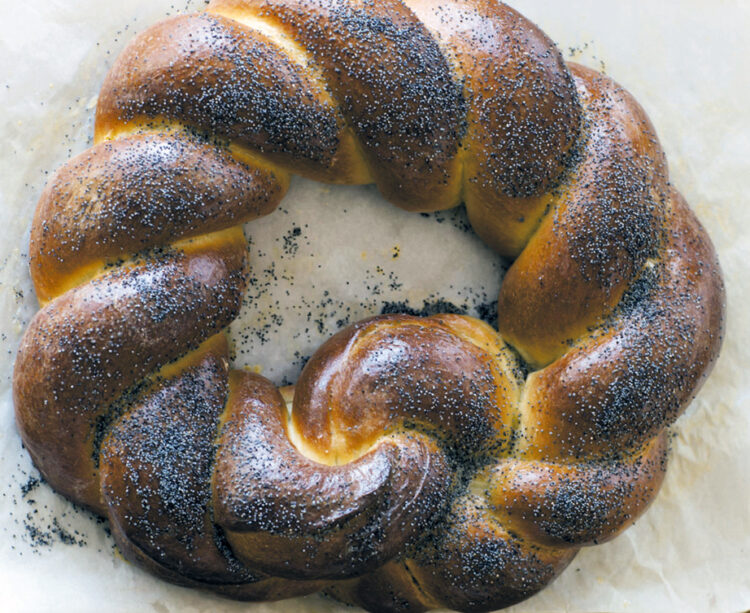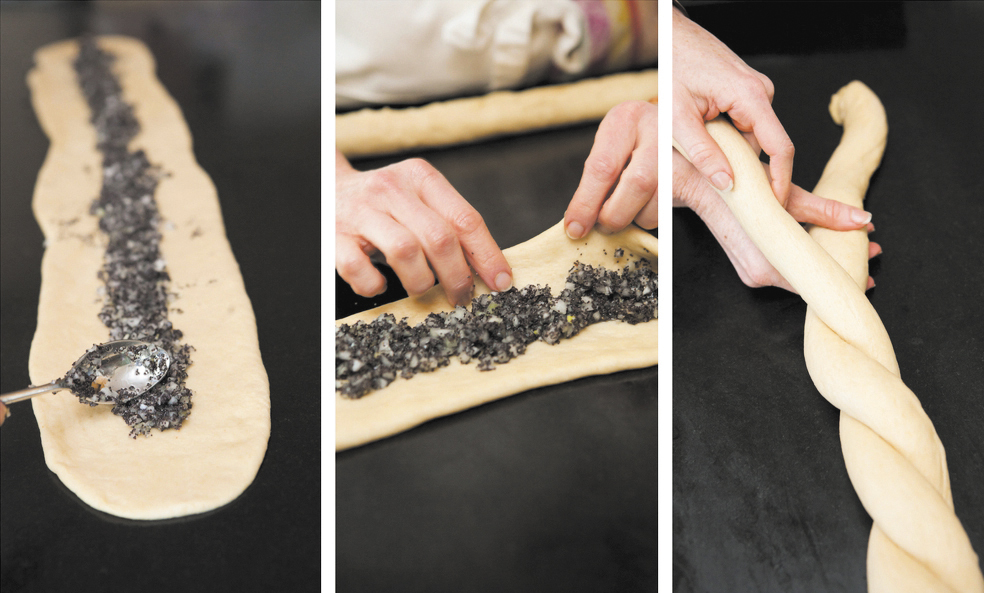Bake a Poppy Seed-Filled Challah this Purim

By Rachel Ringler, The Nosher
Every Jewish holiday has its rules and the foods you should eat. And Purim is no different.
We’re expected to listen to its story during the reading of the Megillah. We are obliged to remember those less fortunate through tzedakah or righteous giving.
We are told to enjoy a celebratory feast. And, finally, we are commanded to share our joy by sending festive food packages to at least one other person.
Each of those packages should contain a minimum of two items, one of which is baked.
It’s most traditional to find hamantashen in these little packages, but there is no rule that it must be, which is good news for those eager to try something else.
 Cookbook author and baker Katja Goldman prepares breads in the shape of a crown and stuffs them with foods both healthy and savory, referencing the crown worn by Queen Esther, the title character and heroine of this story.
Cookbook author and baker Katja Goldman prepares breads in the shape of a crown and stuffs them with foods both healthy and savory, referencing the crown worn by Queen Esther, the title character and heroine of this story.
Katja’s stuffing is a reminder of the foods that tradition tells us Esther allowed herself to eat while living in the palace with her Persian husband, King Ahashverus.
Esther was a Jew, but she kept her religion and true identity from her husband. She kept the laws of kosher eating, kashrut, by eating a vegetarian diet, one rich in seeds and beans.
This savory bread recipe is a cross between a challah and a bialy, stuffed with onion and poppy seeds and topped with more beautiful poppy seeds. So if poppy-seed hamantashen aren’t quite your thing, this stuffed challah might be a delicious counterpoint.
The recipe is excerpted with permission from The Community Table, Recipes & Stories from the Jewish Community Center in Manhattan & Beyond by Katja Goldman, Judy Bernstein Bunzl and Lisa Rotmil.
For the bread
1 cup warm water (105 degrees)
1 package dry yeast
1 tsp. plus 2 ½ Tbsp. sugar
2 Tbsp. honey
2 extra-large eggs
3 to 3 ½ cups unbleached, all-purpose flour, as needed, plus more for dusting
2 tsp. kosher salt
½ cup grapeseed or safflower oil, plus more for oiling the bowl
½ cup white whole-wheat flour
½ cup bread flour
1½ Tbsp. of one or a combination of sesame seeds, poppy seeds and za’atar (optional)
For the filling
1½ cups very finely chopped yellow onion
6 Tbsp. olive oil
½ cup poppy seeds
½ tsp. kosher salt
For the glaze
1 extra-large egg beaten with 2 Tbsp. water
To make the bread: place the warm water in a large bowl and sprinkle the yeast and one teaspoon sugar over the water. Let stand until foamy, about 10 minutes.
Add the honey, eggs, one cup of all-purpose flour, and the remaining sugar to the yeast. Beat hard with a bread whisk or stir vigorously with a wooden spoon until smooth.
Add the salt and oil and continue to whisk or stir until the oil is incorporated. Stir in white whole-wheat and bread flour. Gradually add remaining all-purpose flour, starting one cup at a time.
When you can no longer stir in the bowl, transfer to a lightly floured surface and continue to gradually add flour, kneading gently until dough is smooth, elastic, and no longer sticky. (The flour amount may vary depending on the age of the flour, the humidity, and the size of your eggs.) Form the dough into a ball.
Oil a large bowl and add the dough, turning it once to coat it. Cover the bowl with a damp cloth and place it in a warm, draft-free spot, such as in an oven that is turned off. Allow the dough to double in bulk, one to two hours.
Poke the dough with two fingers; if the indentations remain, the dough has adequately risen; if the indentation fills in, cover the dough and allow it to rise 15 to 30 minutes more.
While the dough is rising, combine the onion, olive oil, poppy seeds, and salt in a small bowl.
Divide the dough portion into two pieces. Using your hands, roll one piece into a 26-inch-long strand.
Then, using a rolling pin or your hands, flatten the strand into a 30-x-4 inch rectangle. (If the dough is too elastic to hold the rolled out shape, let it rest for 10 to 15 minutes on the counter and roll it again.)

Spoon half of the onion-poppy mixture lengthwise down the center of the dough. Fold one long edge of the dough to just cover the filling.
Take the second side of the dough and fold it so that it overlaps the first side by a half inch.
Pinch firmly to seal. Pinch the short ends closed.
Repeat with the second piece of dough.
Arrange the filled strands side by side, seam-side down. Beginning in the middle, cross one strand over the other to form an X-shape, being careful to keep the seams facing down. Starting from the middle cross, continue to cross the strands, one over the other in the same direction until you reach the end.
Pinch the ends together. Repeat with the other end. Coil it into a ring and transfer it to a parchment-lined baking sheet, seam-side down.
Tuck one end under the second and pinch to seal tucked end.
Preheat oven to 350 degrees.
Let the ring rise for about one hour in a warm, draft-free place, until doubled in size.
Glaze with the egg wash and sprinkle with more seeds, if desired. Bake for 45 to 50 minutes.
Rotate the baking sheet in the oven halfway through the baking. The bread should be golden brown and sound hollow when tapped.
The internal temperature can be tested with an instant-read thermometer and should be 190 degrees.
To read the complete February Dayton Jewish Observer, click here.

